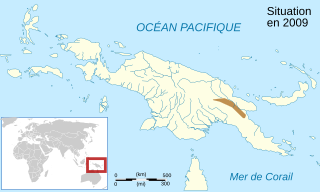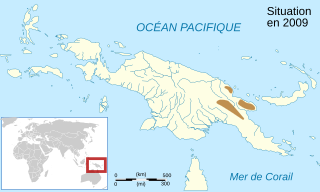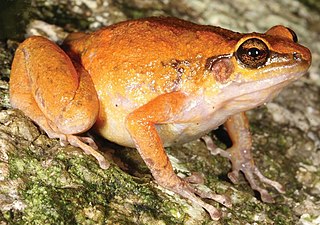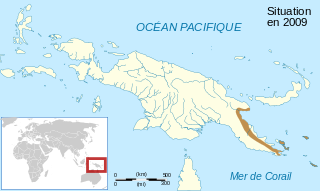
Vanatinai Island is a volcanic island in the southeast of the Louisiade Archipelago within Milne Bay Province of Papua New Guinea. The reef-fringed island is approximately 360 kilometres southeast of New Guinea and 30 kilometres south of Misima. With an area of 830 square kilometres, it is the largest island of the archipelago. Tagula town, the main settlement, is located on the northwest coast. The population was 3,628 as of 2014. The principal export is copra.

Barygenys is a genus of microhylid frogs. They are endemic to New Guinea and the adjacent Louisiade Archipelago. So far only known from Papua New Guinea, the range of the genus is expected to reach Papua province in the Indonesian part of New Guinea. Despite not being known from Papua, common name Papua frogs has been suggested for them.
Nyctimystes perimetri, also known as the archipelago big-eyed treefrog, is a species of frog in the subfamily Pelodryadinae of the family Hylidae. It is endemic to Papua New Guinea and currently only known from the Louisiade Archipelago, although it might also occur in the Owen Stanley Range of the mainland Papua New Guinea. It has also been suggested that the Rossel Island population might represent a distinct species.
Choerophryne darlingtoni is a species of frog in the family Microhylidae. It is endemic to Papua New Guinea and found in the New Guinea Highlands. The specific name darlingtoni honors P. Jackson Darlington Jr., an American evolutionary biologist and zoogeographer. Common name Darlington's rainforest frog has been coined for it.
Choerophryne variegata is a species of frog in the family Microhylidae. It is endemic to West Papua, Indonesia, and is only known with certainty from its type locality, Digul River. It is assumed that most records from elsewhere refer to other, possibly undescribed species. As the species is only known from one specimen from its vaguely stated type locality, its ecology is essentially unknown, although it is presumed to be a rainforest inhabitant. No other specimen has been collected anywhere near the type locality. Despite all this, vernacular name common rainforest frog has been coined for it.
Aphantophryne sabini is a species of frog in the family Microhylidae. It is endemic to Papua New Guinea and is only known from the region of its type locality, Myola Guest House in the Owen Stanley Range, Northern Province. The specific name sabini honors Andrew E. Sabin, an American businessman, philanthropist, and environmentalist who joined the expedition during which the holotype of this species was collected. However, its vernacular name Guest House Guinea frog refers to the type locality instead.
Austrochaperina aquilonia is a species of frogs in the family Microhylidae. It is endemic to the Sandaun Province, north-western Papua New Guinea. It is only known from two nearby locations in the Torricelli Mountains: Mount Somoro and from the village of Wilbeite. The specific name aquilonia is a Latin adjective meaning "northern" and refers to the range of this species in the north coast mountains of New Guinea.
Austrochaperina blumi is a species of frog in the family Microhylidae. It is endemic to New Guinea and known from the northern slopes of the New Guinean Central Range in Western New Guinea (Indonesia), and from the Bewani, Torricelli, and Hunstein Mountains in Papua New Guinea. The specific name blumi honors J. Paul Blum, the herpetologist who collected the type series. Common name Kosarek land frog has been proposed for it.
Barygenys exsul is a species of frog in the family Microhylidae. It is endemic to Papua New Guinea. It is known from Rossel and Sudest Islands in the Louisiade Archipelago, east of New Guinea. It is uncertain whether the specimens from Sudest really are conspecific with this species. Barygenys apodasta and Barygenys resima were mixed with this species prior to their description in 2013.
Callulops boettgeri, also known as Boettger's Callulops frog, is a species of frog in the family Microhylidae. It is endemic to Halmahera in the Maluku Islands of Indonesia. It is only known from the holotype collected from Galela in 1894. The genus-level placement of this little known frog has changed many times, and it is still unclear whether it should be placed in some other genus.
Cophixalus nubicola is a species of frog in the family Microhylidae. It is endemic to Papua New Guinea and only known from its type locality, Mount Michael in the Eastern Highlands Province. The specific name nubicola refers to its cloud-swept habitat. Common name Michael rainforest frog has been coined for this species.

Cophixalus parkeri is a species of frog in the family Microhylidae. It is endemic to Papua New Guinea where it occurs in the central mountainous region between Chimbu and Morobe Provinces. The specific name parkeri presumably honours Hampton Wildman Parker, an English zoologist and herpetologist to whose perusal Arthur Loveridge sent the holotype. Common name Papua rainforest frog has been coined for it.

Cophixalus pipilans is a species of frog in the family Microhylidae. It is endemic to northern mainland Papua New Guinea and occurs between Lae and the Adelbert Mountains. The specific name pipilans is derived from the Latin verb pipilio and means "peeping". Common name Sempi rainforest frog has been coined for this species.
Cophixalus pulchellus is a species of frog in the family Microhylidae. It is endemic to mainland Papua New Guinea and only known from its type locality in the Hunstein Mountains ; a northern offshoot of the Central Dividing Range. The specific name pulchellus is diminutive of Latin pulcher, meaning "beautiful".
Cophixalus riparius is a species of frog in the family Microhylidae. It is endemic to Papua New Guinea and occurs in the New Guinea Highlands in Madang, Southern Highlands, and Western Highlands provinces southeastward to the Morobe Province. The specific name riparius refers to the creek-side habitat from which many specimens in the type series were collected. Common name Wilhelm rainforest frog has been coined for this species.

Cophixalus shellyi is a species of frog in the family Microhylidae. It is endemic to Papua New Guinea and occurs in the New Guinea Highlands as well as in the Adelbert Range and on the Huon Peninsula. The specific name shellyi honors Father Otto Schellenberger ("Shelly"), an American missionary and former professor in mathematics who collected the type series.

Cophixalus zweifeli is a species of frog in the family Microhylidae. It is endemic to northern Queensland, Australia, and only known from the area of its type locality in the Cape Melville National Park. The species was named to honour American herpetologist Richard G. Zweifel. Common name Zweifel's frog has been coined for it. It is one of the five northeast Australian Cophixalus species that are specialized in boulder field habitats.

Sphenophryne thomsoni, sometimes known as Thomson's toothless frog, is a species of frog in the family Microhylidae. It is endemic to Papua New Guinea and occurs in the southeastern peninsular New Guinea, Louisiade Archipelago, d'Entrecasteaux Islands, and Woodlark Island. It was formerly in its own monotypic genus Genyophryne. The specific name thomsoni honours Basil Thomson, a British intelligence officer, police officer, prison governor, colonial administrator, and writer.
Sphenophryne coggeri is a species of frog in the family Microhylidae. It is endemic to New Guinea and known from two regions in Papua New Guinea, one in the Madang Province and the other in the Southern Highlands Province. The specific name coggeri honors Harold Cogger, a herpetologist from the Australian Museum.
Cornufer gilliardi, commonly known as Gilliard's wrinkled ground frog, is a species of frog in the family Ceratobatrachidae. It is endemic to the Whiteman Ranges of New Britain, Bismarck Archipelago. The specific name gilliardi honors Ernest Thomas Gilliard, an American ornithologist who, together with Margaret Gilliard, collected the holotype.








